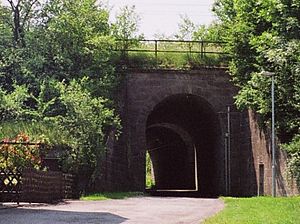Arenshausen – Friedland railway line
| Friedland (Han) –Arenshausen | |||||||||||||||||||||||||||||||||||||||||||||||||||||||||||||
|---|---|---|---|---|---|---|---|---|---|---|---|---|---|---|---|---|---|---|---|---|---|---|---|---|---|---|---|---|---|---|---|---|---|---|---|---|---|---|---|---|---|---|---|---|---|---|---|---|---|---|---|---|---|---|---|---|---|---|---|---|---|
|
Double bridge in Arenshausen, in front the route to
Friedland, behind it to Eichenberg | |||||||||||||||||||||||||||||||||||||||||||||||||||||||||||||
| Route length: | 6.8 km | ||||||||||||||||||||||||||||||||||||||||||||||||||||||||||||
| Gauge : | 1435 mm ( standard gauge ) | ||||||||||||||||||||||||||||||||||||||||||||||||||||||||||||
|
|||||||||||||||||||||||||||||||||||||||||||||||||||||||||||||
The Arenshausen – Friedland line was a main line in Lower Saxony and Thuringia , which covered the Göttingen – Bebra and Halle (Saale) Hbf – Hann. Münden , bypassing the Eichenberg node . It branched off from the Göttingen – Bebra railway line in Friedland and led to Arenshausen , where it joined the Halle – Hann railway line. Münden merged. The line was closed in 1892, and a section later served as a connecting line for an industrial company.
history
Construction of a railway line from Halle towards Kassel began as early as 1863 and gradually opened via Sangerhausen (1865), Nordhausen (1866) to Arenshausen (1867). As the railway line from Hanover via Göttingen to Friedland was also completed at this point and Prussia had annexed the Kingdom of Hanover in 1866, it was decided to connect the two railway lines. The section between Arenshausen and Friedland was also opened as a single-track line in 1867.
Due to the geographical location in the Leinetal, larger railway systems were not required, only a few bridges and water passages had to be built. There were initially 3 passenger trains in each direction. A train station or passenger stop was not planned on this short section of the route. A locomotive shed was built in Arenshausen and Leinefelde, connected to it were a water station, coaling station and a turntable; both stations were probably designed as a hub. There were sidings in Niedergandern and near Hottenrode to a brick factory.
In 1872 the originally planned route from Halle to Kassel via Arenshausen-Eichenberg-Hann. Münden released, at the same time the Eichenberg station went into operation. In 1876 the railway line from Göttingen to Bebra between Friedland, Eichenberg and Niederhone near Eschwege was finally opened. The Eichenberg station thus became the crossing station of the north-south and east-west routes and not Arenshausen or Witzenhausen as originally planned. As a result, this section of the route lost its importance and was closed in 1876 for passenger traffic and in 1884 for goods traffic as well. From 1885/86 the existing railway line from Arenshausen in the direction of Eichenberg was expanded to two tracks.
The section between Friedland and Niedergandern was dismantled in 1892, the remaining section between Arenshausen and Niedergandern was used as a connecting line for the Hottenrode brickworks until around 1945. After 1945, the interzonal border or the inner-German border finally separated the Arenshausen – Hottenrode and Arenshausen – Eichenberg sections west of Arenshausen. In 1990 the gap between Arenshausen and Eichenberg was restored.
Eichenberger curve
In a consultation of the railroad departments of the Bundesbahn and Reichsbahn on January 12, 1990 to close the gap between Arenshausen and Eichenberg, the construction of a connecting curve between Arenshausen and Friedland was initially dispensed with. Finally, in 1997, construction of a direct connection from Arenshausen to Friedland began, the Eichenberger curve north of the Eichenberg train station. It should enable direct connections between Erfurt or Halle and Göttingen and enable a supraregional transport connection to the Ruhr area. The connecting curve was opened on September 22, 1998. This saves the trains having to change the direction of travel at Eichenberg station and the associated time-consuming transfer of the locomotive to the other end of the train. This short connecting route touches the three federal states of Hesse, Lower Saxony and, to a lesser extent, Thuringia directly at the triangle .
literature
- Paul Lauerwald: New railway construction in the Thuringian-Hessian-Lower Saxony border area. In: Eichsfeld. Monthly magazine of the Eichsfeldes. Druck und Verlag Mecke Duderstadt, Issue 7/8 1999, pp. 245–249
- Günter Walter, Wolfgang Klee: Border experience, Eichenberg station and the Halle-Casseler railway. Railway history booklet 35
Web links
- forget-bahnen.de current state of the route with numerous photos
- werra-meissner-bahnen to the Eichenberg railway junction
Individual evidence
- ↑ Railway Atlas Germany 2007/2008 . 6th edition. Schweers + Wall, Aachen 2007, ISBN 978-3-89494-136-9 .
- ↑ Timetable of the route Halle to Göttingen and back for the year 1867
- ^ Paul Lauerwald: The railway in the Eichsfeld. Heiligenstadt 1988, p. 17
- ↑ Paul Lauerwld: 20 years ago: First gap in the German-German rail network after 45 years of division. In: Eichsfelder Heimatzeitschrift, printing and publishing house Mecke Duderstadt, 54th year (2010), issue 5, p. 161
- ↑ Göttingen City Archives 1998

